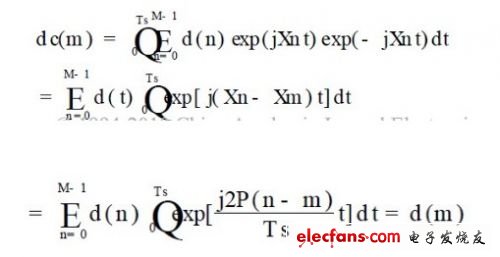1 Introduction
In the 21st century, the rapid development of mobile communication technology and the market, with the joint effect of new technologies and market demand, the third generation mobile communication system -3G has emerged. The code division multiple access (CDMA) technology is used in 3G to deal with multipath problems To obtain multipath diversity gain.
However, in this system, multi-path interference and multi-user interference always coexist. When there are many users, it is very difficult to realize multi-user detection. And CDMA itself is a self-disturbing system, all mobile users occupy the same bandwidth and frequency, so in the case of limited system capacity, the greater the number of users, the harder it is to achieve a higher communication rate, so the 3G system provides 2Mb / s bandwidth is shared. When multiple users use it at the same time, the average bandwidth available to each user is much lower than 2Mb / s, and such bandwidth cannot meet the needs of mobile users for some multimedia services.
The integration and collaboration of technologies in different fields, along with the intelligence of new wireless broadband technology and new services targeted at users, all of this will inevitably produce a new generation of mobile communication system 4G. Compared with 3G, 4G can provide a data transmission rate of up to 100Mb / s, support multimedia services from voice to data, and can achieve higher spectrum utilization and lower cost.
In order to achieve the above goals, other breakthrough technologies such as CDMA in 3G must be used in 4G, especially to study how to support high data rate data transmission stably, reliably, and efficiently in the mobile environment and limited spectrum resources. . Therefore, OFDM technology is adopted as the core technology in the 4G mobile communication system. It can effectively increase the transmission rate, increase the system capacity, avoid various interference caused by high speed, and has good anti-noise performance and multi-path resistance. The advantages of channel interference and high spectrum utilization rate.
This article will introduce the basic principles of OFDM and the implementation of its modulation / demodulation technology and cyclic prefix technology, and compare and analyze OFDM and CDMA technologies in three main aspects.
2 OFDM technical analysis
2.1 Basic principles of OFDM
The basic principle of Orthogonal Frequency Division Multiplexing can be summarized as follows: a high-speed data stream is converted through serial-parallel conversion and distributed to several sub-channels with relatively low transmission rates for transmission. In the frequency domain, the channel is divided into several mutually orthogonal sub-channels, each sub-channel has its own carrier to be modulated separately, and the signal is independently transmitted through each sub-channel.
Due to the multipath propagation effect, the received signals will overlap each other, causing mutual interference between the signal waveforms and forming inter-symbol interference. If the bandwidth of each sub-channel is divided sufficiently narrowly, the frequency characteristics of each sub-channel can be approximately regarded as flat of. As shown in Figure 1.

Therefore, each sub-channel can be regarded as an ideal channel without inter-symbol interference. In this way, the received signal can be reliably demodulated without using complicated channel equalization techniques at the receiving end. In an OFDM system, a guard interval is inserted between OFDM symbols to ensure orthogonality between sub-channels in the frequency domain, and to eliminate interference between OFDM symbols due to multipath propagation effects. Therefore, OFDM is particularly suitable for high-speed transmission of data in mobile radio channels with multipath fading. The principle block diagram of OFDM is shown in 2.

As shown in Figure 2, the original high-rate bit stream is converted into several sets of low-rate bit streams d (M) after serial / parallel conversion, and these d (M) are modulated into corresponding frequency-domain signals, and then Add cyclic prefix, D / A conversion, and send it out through RF; after the propagation of the wireless channel, the receiver receives and demodulates it in the reverse order of the transmitter, so as to obtain the original transmitted signal.
In Figure 2, d (M) is the Mth modulation symbol; the expression of the OFDM modulated signal D (t) in the figure is:

In formula (1): T is the symbol period plus guard time; fn is the frequency of each subcarrier, which can be expressed as:

In formula (2): f0 is the lowest subcarrier frequency; Ts is the symbol period.
At the transmitting end, the transmitted data undergoes conventional QAM modulation to form a baseband signal. Then it is converted into M sub-signals through serial-parallel conversion. These sub-signals are then modulated into M sub-carriers orthogonal to each other, where / orthogonal 0 represents the precise mathematical relationship between carrier frequencies, and its mathematical representation is QT0fx (t) fy (t ) Dt = 0, and finally add to OFDM transmission signal. The actual output signal can be expressed as:

At the receiving end, the input signal is divided into M branches, which are mixed and integrated with M sub-carriers respectively to recover the sub-signals, and then the data can be recovered by parallel-serial conversion and conventional QAM demodulation. Due to the orthogonality of the subcarriers, the mixing and integrating circuit can effectively separate the subcarrier channels, as shown in the following formula:

Where dc (m) is the sub-signal of the mth branch at the receiving end. The main difference between OFDM and other technologies in the entire OFDM workflow is the modulation / demodulation technology used and the addition of cyclic prefix. These will be analyzed in detail below.
The hand-held electric fan is intelligently controlled and adjusted in three gears, and the wind power can be adjusted according to your own needs. The lithium battery of the rechargeable fan has strong versatility, recyclable charging, low use cost, simple and elegant appearance, firm structure, small size, light weight and convenience. More unique designs for student travel and outdoor sports bring more comfort to more consumers.
Handheld Fan,Portable Hand Fan,Mini Hand Fan,Mini Handheld Fan
Guangdong Aiyimi Electronic Technology Co., Ltd. , https://www.nbminifan.com